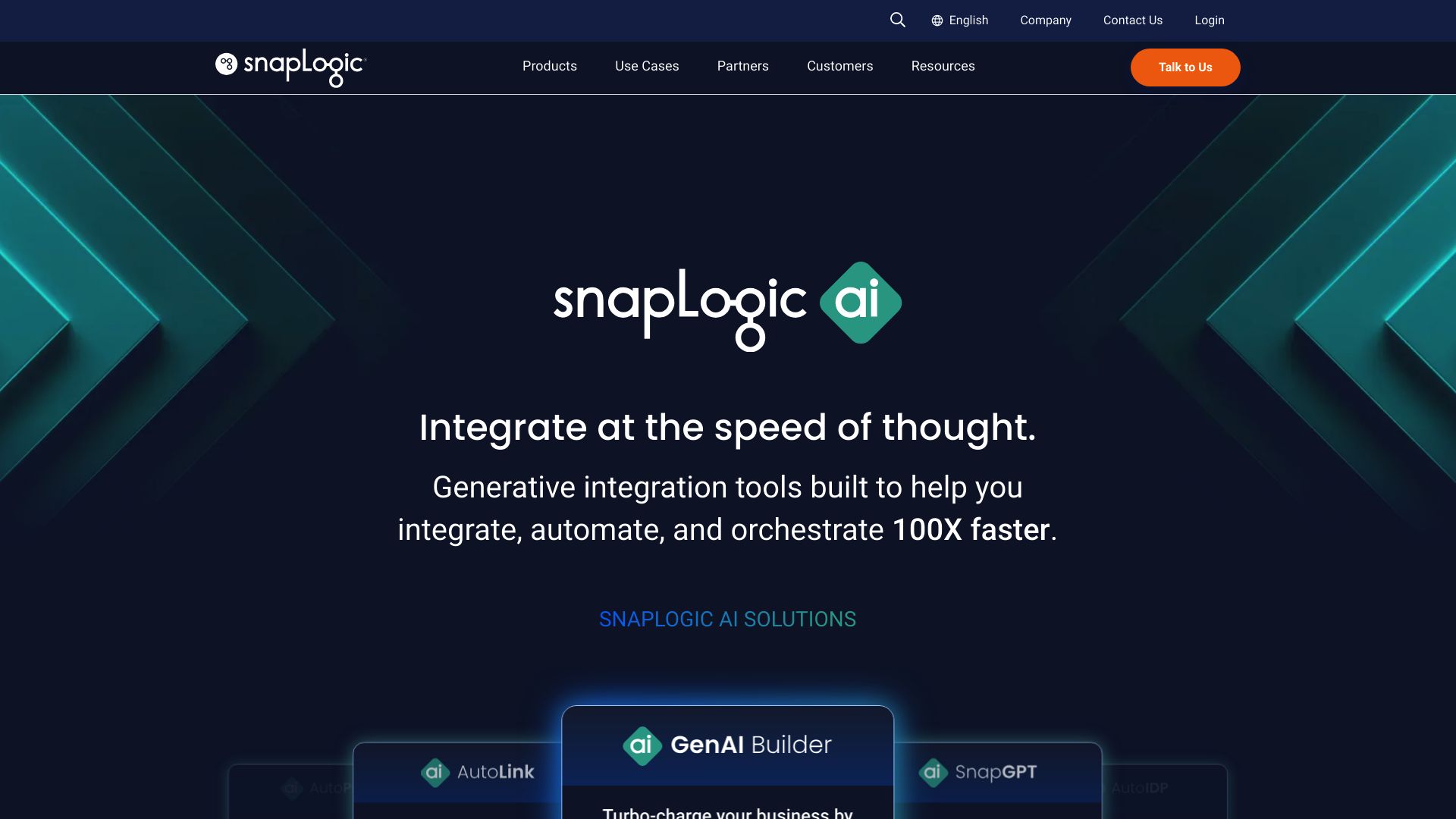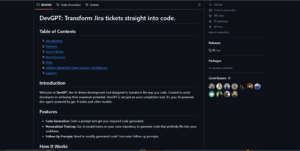snapLogic AI vs. DevGPT: Comparing Enterprise AI Development Platforms
AI-powered development platforms are revolutionizing how businesses create, integrate, and deploy software solutions. This comparison explores snapLogic AI vs. DevGPT, and SmythOS, three leading platforms reshaping the AI development landscape. snapLogic AI offers enterprise-grade data integration and workflow automation. DevGPT focuses on AI-assisted code generation for developers. SmythOS combines these capabilities and more, providing a comprehensive solution for businesses of all sizes. We’ll examine each platform’s strengths, limitations, and unique features to help you choose the best tool for your AI development needs. Whether you’re a seasoned developer, business leader, or AI enthusiast, this analysis will guide you through the evolving world of AI-powered software development.
snapLogic AI Overview
snapLogic AI provides an Intelligent Integration Platform (IIP) that leverages AI-powered workflows to automate enterprise IT integration projects. The platform streamlines design, development, deployment, and maintenance across on-premises, cloud, and hybrid environments. SnapLogic’s solution caters to both expert developers and citizen integrators, offering a scalable platform for managing application and data integration tasks.


SnapLogic’s platform stands out with its AI-driven capabilities, including the Iris AI technology, which provides intelligent recommendations for building data pipelines. The HTML5-based interface supports self-service for users across skill levels, from business analysts to IT professionals. SnapLogic handles a wide array of data types and sources, using “Snaps” as integration connectors to link SaaS and on-premises applications seamlessly.
SnapLogic’s platform stands out with its AI-driven capabilities, including the Iris AI technology, which provides intelligent recommendations for building data pipelines.
Scalability is a key feature of SnapLogic’s offering. The platform leverages Amazon’s Elastic Compute Cloud (EC2) infrastructure, allowing enterprises to scale integration processes as needed, both in the cloud and on-premises. This elastic integration approach optimizes computing power consumption and data proximity.
SnapLogic has recently introduced SnapGPT and GenAI Builder, expanding its no-code development capabilities for AI applications. These tools enable employees to create AI models and chatbots using natural language prompts, further democratizing AI development within organizations.
While SnapLogic offers robust features and AI-driven innovations, users should consider potential limitations. The platform’s extensive capabilities may require a learning curve for new users, and the cost structure could be prohibitive for smaller organizations. Additionally, while SnapLogic provides comprehensive integration options, specific niche applications may require custom development or additional plugins.
DevGPT Overview
DevGPT empowers software developers to streamline their coding processes through AI-assisted automation. This open-source platform transforms natural language descriptions into executable code, saving developers significant time on routine tasks.


DevGPT’s key features include personalized training on a developer’s codebase, editable AI-generated outputs, and integration with popular development tools like GitHub and Jira. The platform leverages advanced models such as GPT-4 and Codex to power its code generation capabilities, enabling developers to focus on complex problem-solving rather than repetitive coding tasks.
DevGPT empowers software developers to streamline their coding processes through AI-assisted automation. This open-source platform transforms natural language descriptions into executable code, saving developers significant time on routine tasks.
While DevGPT offers impressive time-saving benefits, with users reporting over 10 hours saved per week, its current focus on individual developers and small teams may limit its scalability for larger organizations. The platform’s reliance on external AI models could also pose potential challenges in terms of customization and data privacy for enterprise users.
DevGPT’s vision extends beyond individual productivity gains. The platform aims to become an indispensable AI-powered coding companion for developers and software teams of all sizes. By fostering an engaged community of users and contributors, DevGPT seeks to drive future product development and expand its accessibility to companies across the spectrum.
As the AI development landscape evolves, DevGPT’s success will likely depend on its ability to maintain a balance between user-friendly interfaces and advanced capabilities, while addressing potential scalability and integration challenges for larger teams and enterprises.
Feature Comparison
snapLogic AI and DevGPT offer distinct approaches to AI-powered development, with each platform addressing different needs. snapLogic AI excels in enterprise-grade data integration and automation, leveraging AI to streamline complex workflows across various environments. Its robust set of features includes hosted agents for both development and production, a visual builder for creating data pipelines, and strong support for multi-agent collaboration.
DevGPT, on the other hand, focuses primarily on code generation and developer assistance. While it provides powerful AI-driven coding capabilities, it lacks some of the comprehensive integration and deployment options offered by snapLogic AI. DevGPT’s strength lies in its ability to transform natural language descriptions into executable code, but it falls short in areas like data lake support, webhook deployment, and the range of AI foundation models supported.
In terms of security, snapLogic AI demonstrates a more mature offering with features like data encryption, OAuth support, and IP control. DevGPT, being primarily focused on code generation, does not explicitly mention such robust security measures. This gap in security features could be a significant consideration for enterprise users looking to implement AI solutions at scale.
Feature Comparison Table
| snapLogic AI | DevGPT | SmythOS | |
|---|---|---|---|
| CORE FEATURES | |||
| Hosted Agents (Dev, Production) | ✅ | ❌ | ✅ |
| Environments (Dev, Production) | ✅ | ❌ | ✅ |
| Visual Builder | ✅ | ❌ | ✅ |
| No-Code Options | ✅ | ❌ | ✅ |
| Memory & Context | ❌ | ✅ | ✅ |
| Autonomous Agents | ✅ | ❌ | ✅ |
| Explainability & Transparency | ✅ | ❌ | ✅ |
| Multimodal | ✅ | ❌ | ✅ |
| Multi-Agent Collaboration | ✅ | ❌ | ✅ |
| Audit Logs for Analytics | ✅ | ❌ | ✅ |
| Bulk Work | ✅ | ❌ | ✅ |
| Agent Work Scheduler | ✅ | ❌ | ✅ |
| Logs & Monitoring | ✅ | ❌ | ✅ |
| SECURITY | |||
| Constrained Alignment | ✅ | ❌ | ✅ |
| Data Encryption | ✅ | ❌ | ✅ |
| OAuth | ✅ | ❌ | ✅ |
| IP Control | ✅ | ❌ | ✅ |
| COMPONENTS | |||
| Foundation AIs | ❌ | ❌ | ✅ |
| Huggingface AIs | ❌ | ❌ | ✅ |
| Zapier APIs | ❌ | ❌ | ✅ |
| All other APIs, RPA | ✅ | ❌ | ✅ |
| Classifiers | ❌ | ❌ | ✅ |
| Logic | ✅ | ❌ | ✅ |
| Data Lakes | ✅ | ❌ | ✅ |
| DEPLOYMENT OPTIONS (EMBODIMENTS) | |||
| Deploy as API | ✅ | ❌ | ✅ |
| Deploy as Webhook | ✅ | ❌ | ✅ |
| Staging Domains | ❌ | ❌ | ✅ |
| Production Domains | ❌ | ❌ | ✅ |
| API Authentication (OAuth + Key) | ✅ | ❌ | ✅ |
| Deploy as Site Chat | ❌ | ❌ | ✅ |
| Deploy as Scheduled Agent | ✅ | ❌ | ✅ |
| Deploy as GPT | ❌ | ❌ | ✅ |
| Scalability | ✅ | ❌ | ✅ |
| DATA LAKE SUPPORT | |||
| Hosted Vector Database | ❌ | ❌ | ✅ |
| Sitemap Crawler | ❌ | ❌ | ✅ |
| YouTube Transcript Crawler | ❌ | ❌ | ✅ |
| URL Crawler | ❌ | ❌ | ✅ |
| PDF Support | ✅ | ❌ | ✅ |
| Word File Support | ✅ | ❌ | ✅ |
Best Alternative to snapLogic AI and DevGPT
SmythOS stands out as the superior alternative to snapLogic AI and DevGPT, offering a comprehensive AI automation platform that combines powerful features with unparalleled ease of use. Our drag-and-drop interface empowers users to create sophisticated AI agents without extensive coding knowledge, democratizing AI development across organizations.
SmythOS stands out as the superior alternative to snapLogic AI and DevGPT, offering a comprehensive AI automation platform that combines powerful features with unparalleled ease of use.
Unlike snapLogic AI’s focus on data integration and DevGPT’s narrow scope of code generation, SmythOS provides a versatile ecosystem for building and deploying AI agents across multiple use cases. We offer hosted agents for both development and production environments, ensuring seamless scalability as your needs grow.
Our platform excels in multi-agent collaboration, allowing teams of AI agents to work together on complex tasks — a capability lacking in both snapLogic AI and DevGPT. This collaborative approach, combined with our robust memory and context handling, enables the creation of truly intelligent and adaptable AI solutions.
Our platform excels in multi-agent collaboration, allowing teams of AI agents to work together on complex tasks — a capability lacking in both snapLogic AI and DevGPT.
SmythOS sets itself apart with its extensive deployment options. While snapLogic AI and DevGPT offer limited deployment capabilities, we provide the flexibility to deploy your AI agents as APIs, webhooks, scheduled tasks, or even integrate them directly into popular platforms like ChatGPT. This versatility ensures that your AI solutions can be seamlessly incorporated into existing workflows and systems.
With our comprehensive feature set, including support for various foundation AI models, data lake integration, and advanced security measures, SmythOS empowers you to tackle a wide range of AI challenges. Whether you’re automating business processes, enhancing customer interactions, or developing cutting-edge AI applications, our platform provides the tools and scalability to bring your vision to life.
Conclusion
In comparing snapLogic AI, DevGPT, and SmythOS, each platform offers unique strengths for AI-driven development and automation. snapLogic AI excels in enterprise-grade data integration, providing robust features for complex workflows across various environments. DevGPT focuses on code generation and developer assistance, transforming natural language into executable code. However, SmythOS emerges as the superior choice, combining the best of both worlds with additional innovative features.
SmythOS stands out with its intuitive drag-and-drop interface, extensive integration ecosystem, and versatile deployment options. Unlike its competitors, SmythOS offers a comprehensive solution that caters to both technical and non-technical users, making AI development accessible to a broader audience. The platform’s support for multi-agent orchestration, pre-built API integrations, and templates significantly reduce setup time and enhance productivity.
While snapLogic AI and DevGPT may suit specific use cases, SmythOS’s flexibility and scalability make it the ideal choice for businesses looking to leverage AI across various applications. From creating APIs and chatbots to deploying AI agents on multiple platforms, SmythOS provides a one-stop solution for AI-driven innovation.
To experience the full potential of AI automation and transform your workflow, create a free SmythOS account. With unlimited agents, a 30-day money-back guarantee, and the ability to deploy AI agents anywhere, SmythOS empowers you to revolutionize your business processes. Explore our diverse range of AI-powered agent templates to jumpstart your journey into the future of AI-driven productivity.
Last updated:
Disclaimer: The information presented in this article is for general informational purposes only and is provided as is. While we strive to keep the content up-to-date and accurate, we make no representations or warranties of any kind, express or implied, about the completeness, accuracy, reliability, suitability, or availability of the information contained in this article.
Any reliance you place on such information is strictly at your own risk. We reserve the right to make additions, deletions, or modifications to the contents of this article at any time without prior notice.
In no event will we be liable for any loss or damage including without limitation, indirect or consequential loss or damage, or any loss or damage whatsoever arising from loss of data, profits, or any other loss not specified herein arising out of, or in connection with, the use of this article.
Despite our best efforts, this article may contain oversights, errors, or omissions. If you notice any inaccuracies or have concerns about the content, please report them through our content feedback form. Your input helps us maintain the quality and reliability of our information.
